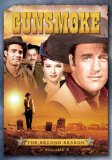The set comprises the second half of the second season of Gunsmoke. The show was still in black and white and in the half hour format. Some of the best episodes of the set included Bloody Hands. For once a western dealt with conscience. When Dillon begins to have haunting dreams and pangs of guilt over killing three bad guys, he tries to back down from a fight. Has Dillon gone yellow? Arness does a better than average job on this rather thought provoking episode. When a man comes from Washington to question Dillon’s methods, he finds out who his friends really are in The Bureaucrat. A man turns up dead in Chester’s Murder just after a fight with Chester so bad Dillon had to break it up. Now Dillon’s got to prove Chester wasn’t the killer, but he’s the worst witness against him. Modern technology reaches Dodge City in The Photographer. Many residents get their first introductions to a camera. But is the stranger with the fancy new camera a killer? Ever notice how a story gets out of hand with each telling? In What The Whiskey Drummer Saw, a story gets out of hand when Dillon’s told he’s about to die. In The Man Who Would Be Marshall, an Army officer wants Dillon’s job; that is, until he finds out just what that job really entails. All in all, this is a solid collection of episodes and certainly won’t be a disappointment to fans who haven’t seen them in decades.
Gunsmoke is the longest running scripted live action television show in history. The series ran from 1955 to 1975. At first it was a half hour black and white show that evolved into a color hour by 1967. It actually started before the days of television, premiering on radio in 1952. Then it was William Conrad as the tough as nails Marshall Matt Dillon. When television came into its own, Gunsmoke made the jump to the bright living room box and made history. Westerns would ride across our small square screens for the next 3 decades, making it the most successful genre of that time, and it was Gunsmoke that started it all. The television version of Gunsmoke was originally conceived as a vehicle for John Wayne, who opted to remain in movies. Yet, it was Wayne himself who suggested James Arness, and it turned out to be a career for the once “carrot” monster from The Thing. Gunsmoke started before all of the big westerns and was around when most of them had departed.
The setting for Gunsmoke was the by now famous Dodge City, circa 1870’s. Phrases like “get out of Dodge” would enter the popular lexicon as a result of this resilient series. Marshall Dillon (Arness) was charged with keeping the peace in Dodge City. The only other character to see the entire 20 year run was kindly Doc Adams (Stone). Star Trek’s own Doc, Leonard McCoy, took many of his traits from Doc Adams. He was the humanitarian of the city, always looking to help someone. Like McCoy, he had a taste for bourbon and a soft heart underneath a rather gruff exterior and was always ready with free advice. Dillon’s love interest throughout most of the series was Miss Kitty Russell (Blake). While there were certainly a few romantic undercurrents, the romance never came to fruition. Miss Kitty was a prostitute on the radio and was likely one here as well, but CBS chose to underplay that aspect of her character as a “saloon girl”. Finally Dillon’s faithful sidekick deputy was Chester (Weaver). Chester often found himself in trouble and was the naïve son figure to Dillon.
Video
Each episode of Gunsmoke is presented in its original broadcast full frame format. The series was shot in black and white. The transfer is not a great one, but you just can’t expect a heck of a lot from a master that is over 50 years old. The detail is actually pretty nice, and the prints are pretty solid, again allowing for age. The real problem is the amount of grain present throughout. The problem is likely the original film stock and can in no way be considered a flaw with the transfer. Black levels fluctuate quite a bit but are usually fair.
Audio
The Dolby Digital Mono track delivers exactly what you are looking for and nothing more. The dialog is clear, and that’s all you’re going to get out of this minimalist presentation.
Special Features
Original Sponsor Spots: This is a short collection of clips of James Arness pushing a product. In the case of this collection, most are for L&M cigarettes. Paramount includes a disclaimer warning that smoking is not being recommended by them; of course in the 1950’s it most certainly was. The rest are for electric shavers.
Final Thoughts
Paramount has this annoying habit of splitting some of these vintage shows into half season sets. So, what you get here is the second half of the second season. We’re only talking a half hour show here, and so you get just three discs instead of the six for a full season. I’m still waiting for a good reason for doing this beyond the “sell two sets for each year” theory. It doesn’t make a lot of practical sense, particularly on such a long running show like Gunsmoke. Will there even be new DVD’s out by the time they get to year 20 at this rate? I suppose one should be glad the studios are releasing so much quality TV on DVD. It sure gives me a lot to watch every night with new DVD’s coming in every day. “I don’t make much profit off of ‘em, but it keeps me from workin’ steady.”






